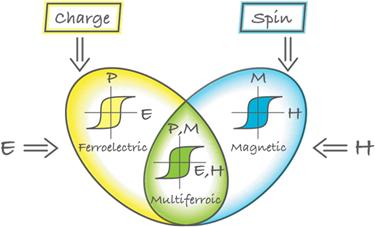In some materials the electric charges show a spontaneous ordering, giving rise to an electric polarization. This polarization can be reversed by an external electric field, and after the electric field is removed the material preserves its polarization state. This effect can be used to store information (Fe-RAM) with lower power consumption and faster writing/reading cycles than the commonly used flash memories. These materials are termed as ferroelectrics.
Other materials show a spontaneous ordering of atomic magnetic moments, which can be visualized as little arrows. If these moments point all in the same direction, they give rise to a net magnetization. This magnetization can be reversed by a sufficiently large external magnetic field. The magnetic state of the material can also be used to store information, as it is done in the case of hard drives. The materials showing magnetic ordering are termed as ferro- or antiferromagnets, depending on the parallel- or antiparallel ordering of the neighbouring moments.
If the two previous effects are simultaneously present, the material is called multiferroic. In this case the electric and magnetic properties are coupled: magnetic state can be modified by an external electric field and electric state can be influenced by an external magnetic field. This coupling can be either an inherent property of the material due to the so called spin-orbit coupling or can come from a mechanical gluing between a ferroelectric and ferromagnetic layer of two different materials. The first case is extremely interesting if we want to understand the microscpic mechanisms governing the electromagnetic properties of the material, and the second one can be promising in the point of view of future information technology applications. In my work I study multiferroic crystals with inherent magneto-electric coupling.
This research was supported by the European Union and the State of Hungary, co-financed by the European Social Fund in the framework of TÁMOP-4.2.4.A/ 2-11/1-2012-0001 ‘National Excellence Program’.

